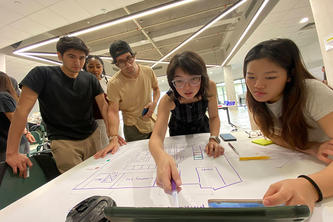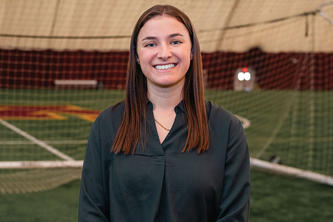
According to a survey from Pew Research Center, 54% of teens say it would be hard to give up social media. As Screen-Free Week approaches in the first week of May, University of Minnesota Professor Jodi Dworkin discusses advice for parents to help manage children’s screen time.
Q: How has screen time usage changed over the last few years?
Prof. Dworkin: We saw the COVID-19 pandemic as an inflection point for how parents viewed acceptable screen time for their children. During an August 2020 survey, 63% of U.S. parents reported they lowered their standards for what they thought was appropriate screen time for their children due to COVID-19. In addition, 70% of parents reported their children were spending four or more hours a day online. This left many parents feeling overwhelmed. In addition to everyone spending more time online, many parents let their children get a cell phone or a social media account earlier than planned to combat social isolation. Children were suddenly using technologies and apps in new ways and parents had to figure it out alongside their teens.
Q: Is all screen time created equal — what are the pros and cons?
Prof. Dworkin: Internet use can provide young people with opportunities to express themselves, try out different identities, connect with others who are like them, and connect with family and friends who are not geographically close. It can also be a good source of information when they have questions they are not comfortable asking someone they know.
But not all screen time is the same. Being online for school is not the same as playing Minecraft, Among Us or Fortnite with friends online. Gaming online with friends is different from interacting with strangers on social media.
When parents and children watch TV or movies, search the internet or even set up a social media account together, there’s an opportunity to talk about responsible online behavior. They can learn from their child how different apps or social media sites work and how other teens are using them. It’s also an opportunity for parents to talk about how to sort through all the information young people find online, how to discern what sources are reliable and to encourage young people to trust their gut. If a site or a person you’re interacting with seems “off,” it probably is.
Screen time can put young people at risk for cyberbullying, interactions with people pretending to be someone else or misuse of personal information. Even if it’s an address or picture that is only intended for one person, it’s important to instill that once information is online, you can’t control how other people will use or share it.
Q: What’s your advice for parents and caring adults who are navigating conversations with children and teenagers about limiting screen time usage?
Prof. Dworkin: Families should have open conversations about why screen time likely increased over the pandemic and why there is an expectation that screen time should change now that kids are no longer in regular distance learning for school and have more chances to interact with friends in person. Engage your child in that discussion — ask them to share what they think are the pros and cons of screen time, and how they think their screen time should change.
Q: How can families build in screen-free time each day?
Prof. Dworkin: Setting family rules about screen time is important, and setting rules before you need them can make them easier to implement. It’s a good idea to have rules that apply to everyone, not just for young people. For example, some family rules that build in screen-free time each day could be no phones or technology at meals or other family activities, or no technology before school or after 9 p.m. Perhaps a few screen-free hours each day are reserved for reading or outdoor play. When parents can model screen-free time and make it part of the family routine, that helps their children understand that screen-free time is important and helps them learn what that time can look like. Setting these rules before there is a problem with too much screen time will make it feel less punitive. Kids may still complain at first when a new rule is implemented but they will soon adjust and find other ways to spend their time.
Q: What does your research show in this area?
Prof. Dworkin: I have been studying families and technology use for more than a decade. It’s not surprising that we consistently find both parents and young people are frequently online and using different online tools to stay connected.
My recent research found that adolescents, young adults and parents still want to communicate and connect in person with family and friends, despite high rates of technology use. This is particularly true when they are seeking advice or emotional support. Checking in or making plans may be better suited to technology communication, and families are more likely to use technology for these tasks. Technology is another tool for maintaining relationships. Parents should not assume children prefer screen time to in-person interactions. Maintaining in-person interactions takes work, but they are really important for strong parent-child relationships throughout the teenage years, and should be balanced with technology use.
Jodi Dworkin is a professor in the College of Education and Human Development’s Family Social Science department. Dworkin is also a University of Minnesota Extension Specialist. Her expertise includes technology and family development; the role of technology in familial communications; promoting positive family development; and parenting adolescents and college students.
###
About the College of Education and Human Development
The University of Minnesota College of Education and Human Development (CEHD) strives to teach, advance research and engage with the community to increase opportunities for all individuals. As the third largest college on the Twin Cities campus, CEHD research and specialties focus on a range of challenges, including: educational equity, teaching and learning innovations, children’s mental health and development, family resilience and healthy aging. Learn more at cehd.umn.edu.
About “Talking...with U of M”
“Talking...with U of M” is a resource whereby University of Minnesota faculty answer questions on current and other topics of general interest. Feel free to republish this content. If you would like to schedule an interview with the faculty member or have topics you’d like the University of Minnesota to explore for future “Talking...with U of M,” please contact University Public Relations at [email protected].
- Categories:
- Education
- Communication
- Early childhood





